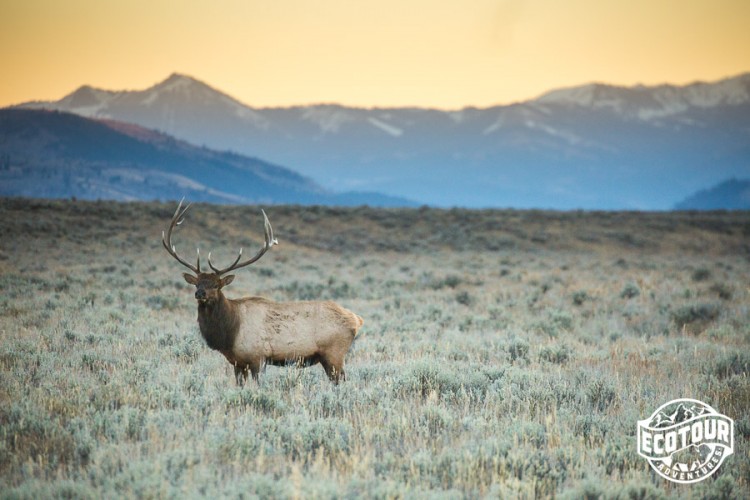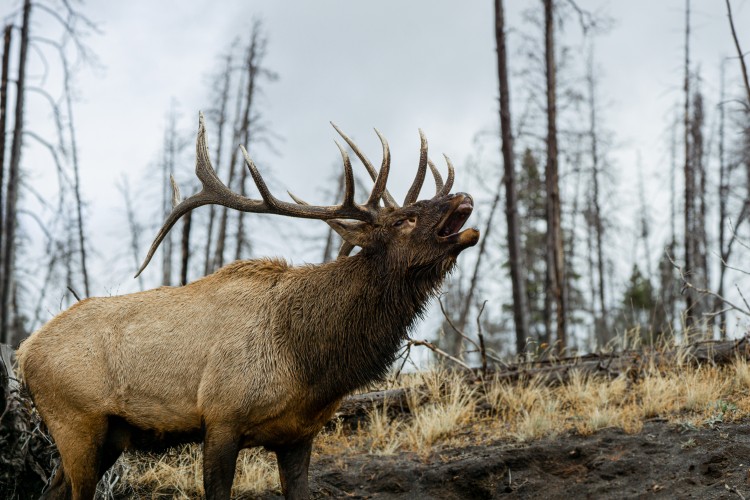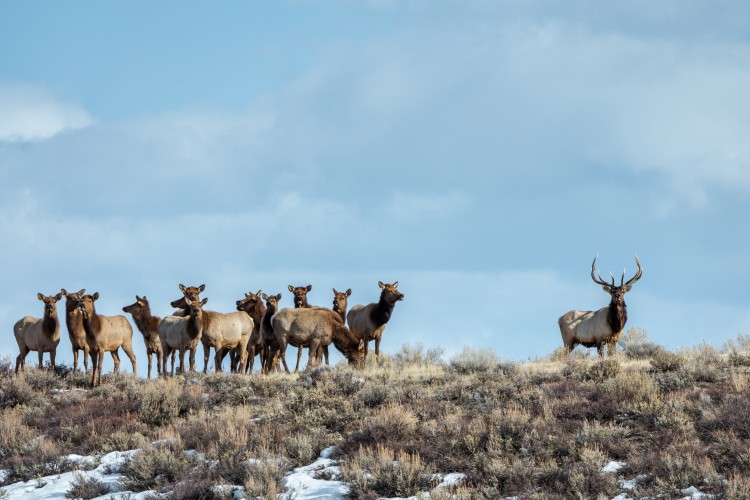What happens during the elk rut?

From mid-September to mid-/late-October, the elk mating season–also known as the rut–is in full swing. The majority of our guides say this is their favorite time to be in the Greater Yellowstone Ecosystem. With elk rutting behaviors on full display, often visible from roadsides, there is rarely a dull moment.
So, what are these behaviors, anyway? What happens during the elk rut?
Bull elk–the males–spend the vast majority of the rut broadcasting their size and superiority. In order for a bull to successfully mate, he has to advertise his fitness as a mate, which is informed by his strength and toughness. Essentially, the stronger a bull is, the healthier he is and the more superior genetics he has. Cow elk–the females–want to mate with the strongest males to ensure their offspring will have the same strong genetics and therefore a greater chance of survival.
So, how do males broadcast their size and strength?
First and foremost, a bull’s antlers reveal a lot about him. Antlers grow back larger with each passing year, so they indicate a bull’s age. Age is indicative of survival–an older bull has had to face many threats over its many years, and the fact that it has survived them all means he is strong. Antlers that are symmetrical also show off a bull’s health. Crooked or malformed antlers could mean the elk may be sick, be injured, have parasites, or have poor genetics.
Secondly, a bull’s bugle advertises his size and dominance to cows and rival bulls. A larger bull will have a deeper and louder bugle, and it will reverberate further across a wide open valley or plain. Bugling can be heard for miles, and this is undoubtedly one of the most magical experiences to have in the Greater Yellowstone Ecosystem. After years and years of guiding here, this sound still gives us chills.

Photo of a bull elk bugling, taken from a vehicle using a telephoto lens. By Kelsey Wellington, ETA Social Media Manager.
Finally, bull elk will spread their scent around by rubbing trees and wallowing, the latter of which involves urinating on the ground and rolling in the urine-soaked soil to really spread their scent around. We know, we know, this sounds pretty gross…but cow elk love it!
Okay, so now we know what tools a bull elk has at his disposal to win over cows. How does he go about using these tools?
Bulls will spend much of their time during the mating season putting on a huge show–bugling loudly, thrashing trees and bushes, and swinging his antlers for all the cows to see. To cows, a bull’s attractiveness comes down to his size and strength–not only do these factors indicate superior genetics, they also mean the cows will be protected from younger bulls who may try to harass them for mating opportunities. This added protection ensures the cows can spend most of their time feeding to prepare for the upcoming winter.
Cows select the bulls, joining a harem of other cows. A bull’s harem typically consists of 15-20 cows. Once part of a harem, it is very difficult for a cow to leave; the bull will herd the female back into the harem if she ever tries to leave it for a rival’s harem.
Bugling doesn’t only attract cow elk. Rival bulls are also drawn in, and they may try to fight for each others’ harems. Typically, bulls avoid fighting whenever possible as it is dangerous and energetically costly. Instead of battling it out, bulls will trash trees and bushes, pace back and forth, and bellow at one another in an attempt to get the other to back down.
When that doesn’t work, however, bulls will lock antlers and begin shoving each other back and forth in a test of strength. The weaker bull will give up and flee while the winner bugles in triumph. These battles can sometimes–but rarely–result in one bull being gored, which can be fatal. Although generally lasting only a few seconds, sparring is quite exhausting.

A bull elk with his harem of cows. By Kelsey Wellington, ETA Social Media Manager.
Now for the final piece of the puzzle: what about actually mating?
When not proudly displaying, bugling, or eating, bull elk will roam from cow to cow, sniffing rumps and tasting the air with their tongues to determine whether a cow is in heat. If a cow is not ready to mate, she will hold her head low and swing it from side to side; the bull will back off. If she is ready, however, she will tolerate the bull’s approach.
By mid-October, the rut comes to a close and mature bulls return to their solitary ways while cows reform their herds, joined by younger bulls. The mature bulls are generally marked with injuries from their many battles, and they are exhausted from the huge physical toll of the displays, challenges, and harem maintenance and defense the rut requires. These actions provide very little time for bulls to feed, so they lose about 20% of their body weight by the end of the season. This can prove fatal for unfit bulls as they approach winter.
If the animals–cows and bulls alike–are healthy enough to survive the brutal Wyoming winter, they will repeat this cycle the next fall, this time with a fresh addition in tow: calves born in the spring–the fruits of this intense labor.













